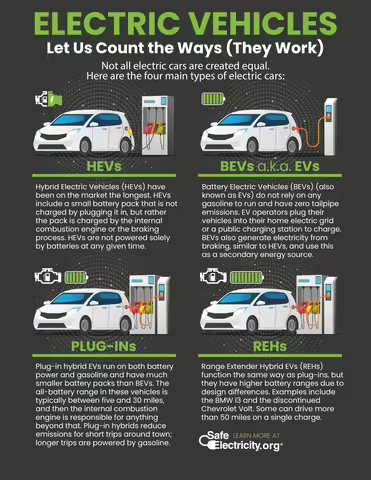Electric Vehicles
Not all electric cars are created equal.
Although electric vehicle (EV) and hybrid technology has been around for longer than most people realize, electric cars are picking up speed in popularity among the masses. And it’s easy to see why: they are environmentally friendly, fun to drive, and they allow you to drive right past the gas station. Read more about electric vehicle safety issues from the Energy Education Council.
Hybrid Electric Vehicles
HEVs have been on the market the longest. HEVs include a small battery pack that is not charged by plugging it in; rather the pack is charged by the internal combustion engine or the braking process. HEVs are not powered solely by batteries at any given time.
Battery Electric Vehicles
BEVs (or simply EVs) do not rely on any gasoline to run and have zero tailpipe emissions. Vehicles are plugged into home electric grid or public charging stations to charge. BEVs also generate electricity from braking and use this as a secondary energy source.
Plug-Ins
Plug-in hybrid vehicles run on both battery power and gasoline and have much smaller battery packs than BEVs. The all-battery range in these vehicles is between five and 30 miles, and then the internal combustion engine takes over. Plug-in hybrids reduce emissions for short trips around town and use gasoline power for longer trips.
Range Extender Hybrids
REHs function like plug-ins, but have a higher battery range. Some can drive more than 50 miles on a single charge.
For more information about electric vehicles, visit: Safe Electricity.
